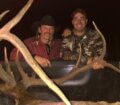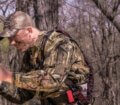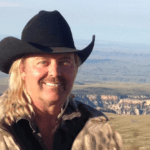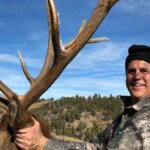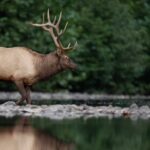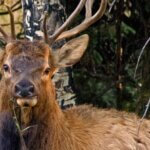Editor’s Note: “Colorado Buck” Ward lives in Texas on his cattle ranch. He’s been hunting and guiding for elk since 1985 and knows what’s required to hunt bull elk successfully.
Best Boots
When asked the most common mistake in equipment that most elk hunters make, Ward answers, “They don’t have adequate footgear for the time of year and the places we’ll be hunting. I like Kenetrek boots. They’re the easiest boots I know to break in before the hunt. They’ve got good Vibram soles that can grip the rocks. If bowhunting during the early season, I suggest that those hunters get boots that are as light as possible. If they’re coming out for the end-of-the-season hunt in cold weather, I recommend the Kenetrek Mountain Extremes boots.”
Guns and Cartridges
Ward recommends elk hunters plan to shoot a 7mm Magnum or a standard big-game rifle. “Don’t get Wildcat cartridges because if you’re flying into camp, and for some reason, your ammo doesn’t reach the airport when you do, you probably won’t be able to find those Wildcat cartridges in most stores,” Ward reports.
“A 7mm Remington and a .300 Win Mag are great elk guns, and you can find ammunition for them almost anywhere you go to hunt elk. If you bring a .280, .30-06, or a .308, if you can put that bullet right where you want it to go at distances out to 300 yards, and that’s the gun you feel comfortable with, then that rifle is much more effective than if you bring a bigger rifle to hunt with that’s so strong it can knock a pickup truck over.”
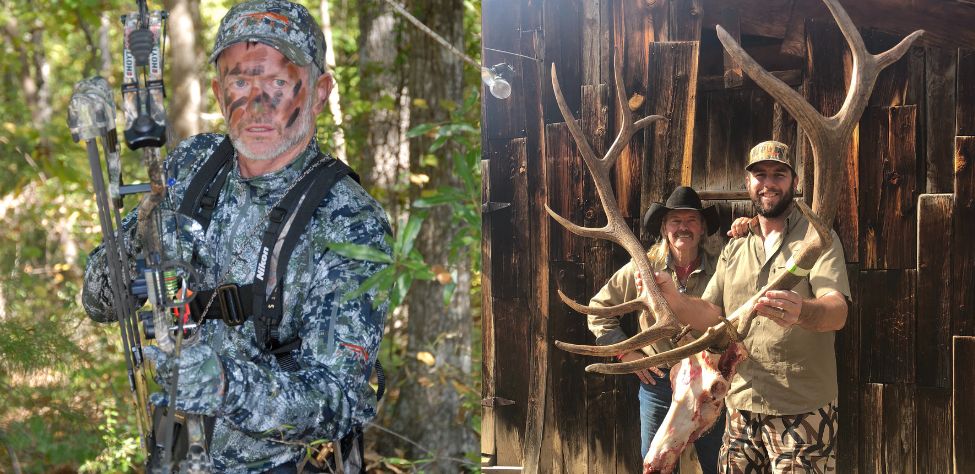
Bowhunting Elk
Because Ward guides bowhunters and gunhunters, I asked him what broadhead he recommends. “I prefer fixed broadheads and no mechanical broadheads at all. I believe the mechanical broadheads have caused more loss of elk than any form of broadhead. An elk is a big animal. When a mechanical broadhead hits a rib cage, it may often break off the blades, which means that you’ve literally shot that animal with a field point. I like a 100-grain or a 125-grain broadhead, depending on how well you can shoot. and how well you can place the arrow.”
Helpful Information for an Elk-Hunting Trip: The camp has Wi-Fi and phone service.
Important documents to bring on the trip: driver’s license; NM Hunting license – (includes elk tag, habitat management, and access validation “stamp”).
Packing List for an Elk Hunting Trip:
1) Personal Pillow
2) Medium Weight Sleeping Bag, December Hunts – Heavyweight Bag. The historic temperatures during elk season are 50-60 degrees, and lows are in the 40s. You can expect a rain/snow mix, depending on weather patterns.
3) Personal prescription medications.
4) Toiletries.
5) Digital camera with extra batteries and memory sticks.
6) Cash for tips and incidentals. Tips = 10-15% of the hunt total, and at your discretion, based on guide and ranch staff performance.
7) Credit card for any additional charges you accumulate at the meat processor.
8) High quality binoculars. Spotting scope and tripod are optional.
9) Towels will be provided.
10) Layering system of clothing: wool blend and/or synthetic fleece (no cotton). Late-season whitetail deer or waterfowl hunting gear will suffice if you don’t have the following items:

1-2 pairs medium-weight pants (camo pattern is encouraged but not required); 2 long-sleeved medium-weight button-up or pull-over shirts; 1-2 medium-weight long underwear tops and bottoms; 1 heavyweight outer jacket of wool blend or synthetic fleece; 1 set waterproof rain pants and parka (“quiet” material preferred in camo pattern or green/brown tones). Weather will most likely include snow, and the rain gear blocks the wind; 2-3 pairs of warm socks, wool blend;
2 pairs gloves: 1 set lightweight, 1 heavy; beanie or other warm head covering, plus neck gaiter or balaclava; baseball cap for sunny days; 1 set comfortable and supportive ankle or calf-high hiking boots, preferably insulated (400gram Thinsulate); knee-high gaiters are also recommended; 1 set house shoes (tennis shoes or loafers);
11) Hiking/trekking poles;
12) Small daypack;
13) Small folding knife;
14) Sunglasses, sunscreen, and Chap Stick;
15) Your CPAP- If you use these, please bring all necessary equipment or let us know IF you need a battery;
16) List of any medical issues or food allergies etc., you may have.
To contact “Colorado Buck” Ward, you can call: 1-800-355-8247.
Expert Guidebooks on Elk Hunting: Best Sellers

Secrets for Hunting Elk
The quickest, easiest (if there is an easy way), and safest way to find and take that bull elk of a lifetime will be to hunt with a guide.
Chad Schearer, a longtime Montana guide and TV personality, told me, “My hunter is my gun. If I get to the elk, and my hunter isn’t with me, then we don’t take the elk. My job is not only to find the elk but also to help the hunter get to the elk and make the experience as enjoyable as I can for him.” That’s the kind of fella with whom I want to go elk hunting.
An elk hunt can be tough, but it doesn’t have to be so tough that you don’t enjoy it. That’s why this elk hunting book starts with the confessions of an elk guide and with Chad Schearer’s philosophy of what the guide and the hunter’s relationship should be.
A good portion of your success will depend on your physical condition, and Matt Morrett of Harrisburg, Pennsylvania explains how an eastern hunter can get ready physically during June and July to hunt western elk, the animals he describes as, “Like deer or turkeys on steroids.”
Wayne Carlton, well-known elk hunter and TV and video personality from Montrose, Colorado, tells us what types of elk calls to use and what to say to the elk. Mike Miller of Colorado, another elk guide and Mossy Oak video personality, has tactics for the best equipment for bowhunting and gun hunting elk.
You’ll learn helpful strategies and hunting tips in this book, as well as some straightforward hunting methods that will help to make your elk hunt more successful.
“Thanks to the advice in your elk hunting books, I was able to call up a nice 6-point (6X6) bull elk! He was bugling like crazy. I called him in from about a ¼ mile away. Called him into bow range (about 40 yards away). It was a thrill!” ~Rob Brannon
VERSIONS: AUDIBLE & KINDLE

Elk: Keys to 25 Hunters’ Success
Often just one tip or tactic makes the difference in whether you take an elk home to dinner or have to hike back to the truck by yourself. In John E. Phillips’ latest elk book, Elk: Keys to 25 Hunters’ Success, you’ll learn from successful elk hunters the strategies they use to find and take elk.
Many know that the technique that seems to work most often is to hunt where other elk hunters don’t and understand where the elk are before you go on a hunt by studying data from each state, visiting HuntData (see chapter 1), examining maps, and reading postings on elk forums.
This book also tells you how to get ready physically for an elk hunt, including participating in Train to Hunt Competitions, what gear you need to take, how to enjoy a successful do-it-yourself elk hunt, or how to pick the best elk guide for you. You’ll also hear about the X System and the Broken Y System of hunting elk.
Although no one person has all the answers on how to help you find and take your elk, I’m convinced that this book’s outdoors men and women will teach you how to have satisfying elk hunts.
As my friend Karl Badger once told me, “Elk hunting doesn’t get any better than when I ride horses into the high backcountry, see two grizzly bears, hear a pack of wolves howl close to camp all night long, eat plenty of delicious food prepared on a fire and enjoy the company of good friends.”
VERSIONS: AUDIBLE, KINDLE & PRINT

How to Find Your Elk and Get Him in Close will teach you the tactics of 10 nationally known elk hunters, to help put that giant bull that’s been screaming at you from afar, in your lap. You’ll learn what some of the best guides, outfitters, and successful elk hunters do to find elk and get them in really close.
Also in this audiobook, you’ll notice that the majority of the experts call elk to within bow range. We selected numerous bowhunters and bowhunting guides, since the bowhunter has to get much closer to a bull than the gun hunter does – often less than 20 or 30 yards – practically in your lap.
On one elk hunt, I’d heard this bull bugle all morning. My guide had called him within 30 yards, and he was standing just inside black timber. I saw the smoke from his nose wafting out into the icy air less than 30-yards away. All the bull had to do was step out, and I could take the shot with my bow. But then, through no fault of my guide or me, the bull vanished.
The only conclusion I could come up with to understand why the bull I wanted to take with my bow hadn’t stepped out and given me a shot, was because he got raptured. He evidently had left the earth with no trace of himself.
This hunt was when I started wanting to learn more about hunting elk up close. In this book, I’ve tried to find some of the most knowledgeable, experienced, and practical elk hunters. I’ve always found that the best way to learn any outdoor skill, is to either hunt or fish with the best sportsmen in that field.
Often, in elk hunting, that means elk guides, who generally hunt every day of the season and receive a salary for every hunter they guide. So, I’ve put together a group of some of the best elk hunters I know to help us all learn how to find bull elk and get them in close.
VERSIONS: AUDIBLE, KINDLE & PRINT

